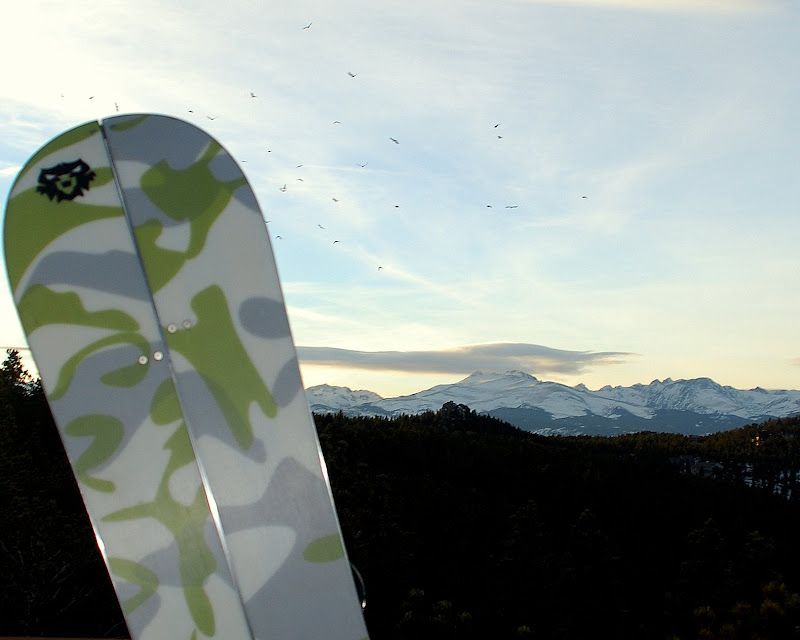 My Khyber and a Colorado sunset.
My Khyber and a Colorado sunset.After a decade or so of research and development, today's splitboards are the harmonious fusion of both ski and snowboard. When used as skis (with their climbing skins), the split-skis allows you to ascend slopes very effectively, the same way an alpine touring or telemark ski would. The width of the split-skis is beneficial. The added float in deep powder helps save the legs when packing an overnighter. However the real fun begins when the two halves are combined to form the snowboard.
Descending on a snowboard is why Splitboards were invented.
The fat mans way to slide; snowboarding deep powder seems effortless on these mountain guns. Even your Tele friends will agree, splitboards have arrived and could even change some perspectives on “Those damn Jibbers”.
Review:
Specs
~Me~
Height: 5'11"
Weight: 205lbs
Boot size: 10.5
Stance: 23 inches (20,20)
Riding Style: Powder hound, steep and deep, tree junkie.
~Board~
Make: Prior
Model: 08 Khyber
Size: 170
Hardware: Vole
Skins: Vole
~Use~
Backcountry riding in all conditions during the Colorado 2007-08 season.
~Snow Conditions for this review~
Mostly Powder! (The snow is awesome this year). But also some wind crust, zipper crust and scoured drifted bullshit.
Overall comments.
Ascending:
Pros: I can climb like a mountain goat on the split-skis! The super-wide skins and the increased surface area had me well in front of my Tele-friends most of the day. I found that the split-skis are about the same or in a few cases a little lighter than AT or Tele setups especially if you consider boot weight. They float and break trail very well even with a full pack (mine is ~30 pounds), and in light fluffy powder. On steep aspects the climbing heel bar is handy and easy to flip up and down.
Cons: This might be because my gear is relatively new but, I found the breaking down and building up of the bindings and interface on the skis was sometimes difficult in cold, icy conditions. Any snow or ice that builds up can interfere and affect the conversion. The fit is very precise and tight which adds to the board’s stable feel, but getting there can require a little poking and scraping. This may be the nature of the beast with the interface, but chipping off ice and snow buildup from the bindings, board interface, touring bracket, as well as the tip and tail locking (Chinese) hooks took some time for the board to fit together properly.
Descending:
Pros: I really like the ride of this board. The Khyber absolutely slays big mountain! I haven't noticed any chattering or wobble at speeds. The board feels solid, responsive and floats very well. It handles the occasional chop and crust the edges are burley and the board seems well crafted. The side-cut, shape and stance options allow the rider to tweak the setup to perfection. I was carving the steeps and weaving through tight trees effortlessly the first day on mine. I didn’t notice any sluggishness or sign that it could be converted into skis…what splitboard?
Cons: This board rides awesome, getting there takes a little practice. When the board is iced packed and your frozen fingers fail to convert the board completely you’ll notice a little slop in the ride. Take the time to bang off ice and snow so that the conversion fits snuggly, there is really no other way it will fit together.

...then hold on to your hat!
~
Product outline by Prior snowboards ~
-------------------------------------------------------------------------------------------------
The Khyber Splitboard is a performance backcountry powderboard whose popularity continues to grow as word spreads about its amazing ride. Its wider nose, generous sidecut and increased taper provide improved float and maneuverability in powder conditions compared with standard freeride shapes. Drop into chutes, pillow lines and trees with quick-turning confidence.
| Riders | The Khyber splitboard is designed for snowboard enthusiasts who desire a performance snowboard that provides unparalleled, self-propelled, backcountry snowboard access combined with a great ride over all winter snow conditions - with an accent on tight trees and terrain requiring extra maneuverability. |
| Ride | The Khyber splitboard trims up in the powder with ease and exceeds all others in tight trees. Its ride is quick turning, stable and predictable. Its tapered shape performs extremely well on hardpack conditions and varied snowpack - something all splitboarders have to deal with at lower elevations at some point during the season. The side-cut is slightly set back due to the width of the nose giving it a "surfy" feel. |
| Recommended length | We suggest you ride the Khyber either the same length as your standard freeride board or a few cm shorter. |
| Conditions | The Khyber excels in powder of all kinds. The Khyber also performs surprisingly well on groomed runs, ice, crud, and all-mountain conditions. It also rides switch with ease. |
| Design | Shape: The Khyber has a longer, wider, more gradually shaped nose than our regular freeride boards for improved float in the powder. A combination of a narrower, shorter tail, setback inserts and significant taper, complete the powder profile. Note there is still plenty of width through the rear insert pack to minimize heel and toe drag. Turning radius: Moderate for quick edge-to-edge transfer and turning ability. Flex: The Khyber is stable underfoot with a slightly softer nose and tail for powder performance. Strength: All Prior splitboards have steel edges and UHMW sidewalls around each board half. This feature combined with Prior's handcrafted sidewall construction and new resin system, results in board longevity- the Khyber splitboard retains its camber and delivers a high performance ride even after several years of hard use. |
-------------------------------------------------------------------------------------------------








 Subscribe to my world.
Subscribe to my world.

